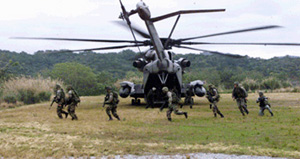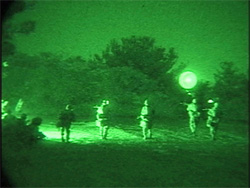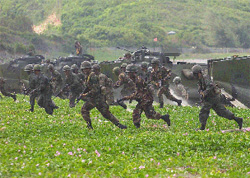
By Mark Oliva, Stars and Stripes
Pacific edition, Monday, August 5, 2002
CAMP HANSEN, Okinawa — Not everyone in the U.S. military carries Beretta’s M-9 9 mm handgun. A small group of Marines still carry .45-caliber pistols — but they’re a far cry from Grandpa’s World War II gun.
Marine Corps officials keep about 500 .45-caliber pistols, based on the Colt M-1911A1 frame. They’re called MEU (SOC) .45s, specially designed for applications within the Marine Expeditionary Unit’s Special Operations Capable missions.
They’re issued to Force Reconnaissance Marines as secondary weapons to submachine guns for their role as the Maritime Special Purpose Force. This gun shoots up close and personal.
Marine Capt. Jeffrey Stower, project officer for the MEU (SOC) .45 at Marine Corps Systems Command in Quantico, Va., said the .45 is essential to Marines’ direct-action missions as a secondary weapon. It’s so important, in fact, that the Marine Corps plans to upgrade the weapon.
The Corps now builds its own specialized version of the .45-caliber pistol from existing M-1911A1 frames still in inventory.
Armorers at the Marine Corps Weapons Training Battalion in Quantico refit the guns. They install new slides, barrels and internal components to what is called “near match” or “combat accuratized” specifications. Each weapon costs about $600 and is good for 30,000 shots before it needs to be refitted.
The planned improvements won’t affect the .45’s appearance or make it shoot faster or more smoothly. But they should make it more durable.
Stower said the Marine Corps wants to put in “hardened, drop-in parts, which would enhance the reliability and endurance of the weapon, as well as lower the echelon of maintenance.”
“The two biggest reasons we carry the .45 pistol,” said Marine Maj. Tracy Tafolla, “is a single-action loader is a little faster for the Marines to use when conducting close-quarters battle.”
“We get faster, stronger and more accurate shots that we just wouldn’t get with a double-action pistol,” said Tafolla, head of the Special Missions branch, III3rd Marine Expeditionary Force Special Operations Training Group. That means Marines can get off a first round faster, smoother and more accurately.

“Another reason we use the MEU (SOC) .45 is because of its ability to incapacitate a hostile person with one round,” Tafolla said. “We’re much more likely to do that with a .45 than with a 9 mm.”
Tafolla said the M-9 9 mm is a good weapon with good attributes. He said the safety of double-action triggers, high-capacity 15-round magazines and the fact it’s the same round used by other NATO allies makes it a natural fit for standard issue. He labeled the M-9 as a “good personal self-defense weapon.”
In fact, the same Marines who carry the beefy .45s also carry MP-5 submachine guns that shoot 9 mm rounds. But when firing those submachine guns, they shoot “double-taps,” or two squeezes on the trigger, to ensure an enemy soldier is hit with a massive amount of lead. Special Operations Training Group instructors teach a single shot to the head for the .45.

The MEU (SOC) .45 also is better able to survive harsh battlefield environments, Tafolla said. It can fire in dirtier conditions that would gum up the M-9; its heavier frame can take more abuse.
“Look at how many decades we’ve been using the .45,” the major said. “It’s a proven weapon.”
Tafolla said Marines using the specialized .45-caliber pistols expect to be fighting within steps of their enemy, “with very little stand-off room.” The time needed to get off a second shot can be the difference between life and death.
“They need a weapon that will be able to put somebody down now,” Tafolla said. “It all comes back to the energy you deliver to the target. Although the 9 mm is faster, the .45 is able to deliver more energy and achieve greater penetration. That’s what you have to have.”
This article is used by permission of the author.
It originally appeared on Stars & Stripes European and Pacific
Photos courtesy of the 31st Marine Expeditionary Unit

Comments, suggestions, contributions? Let me know